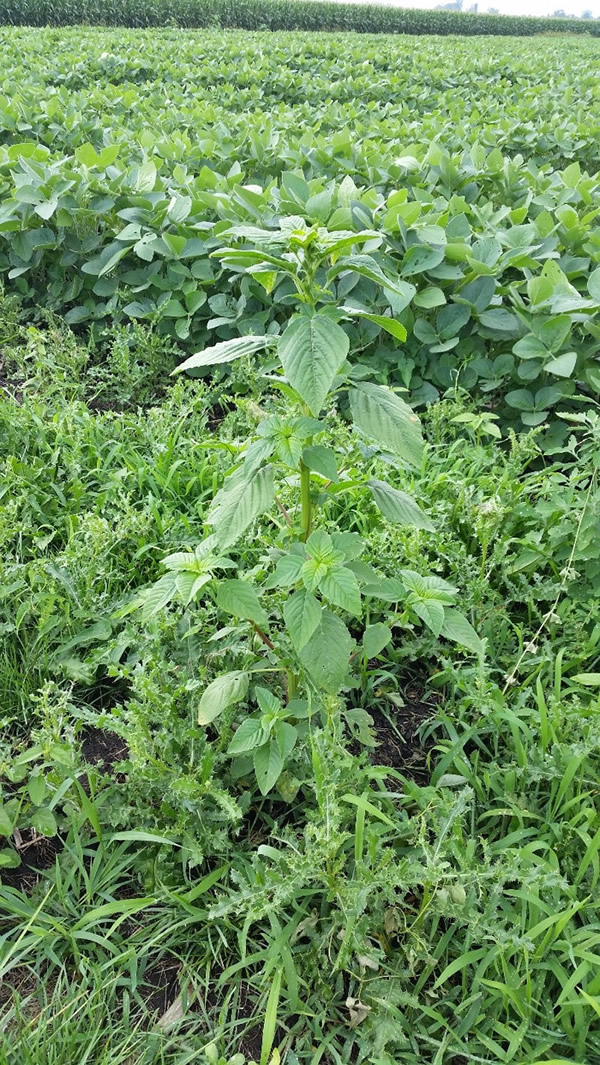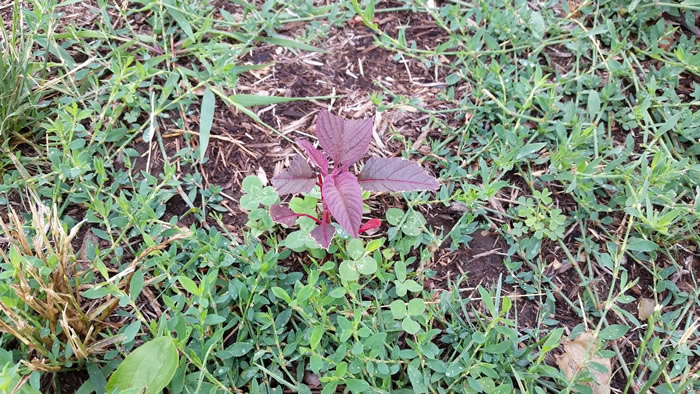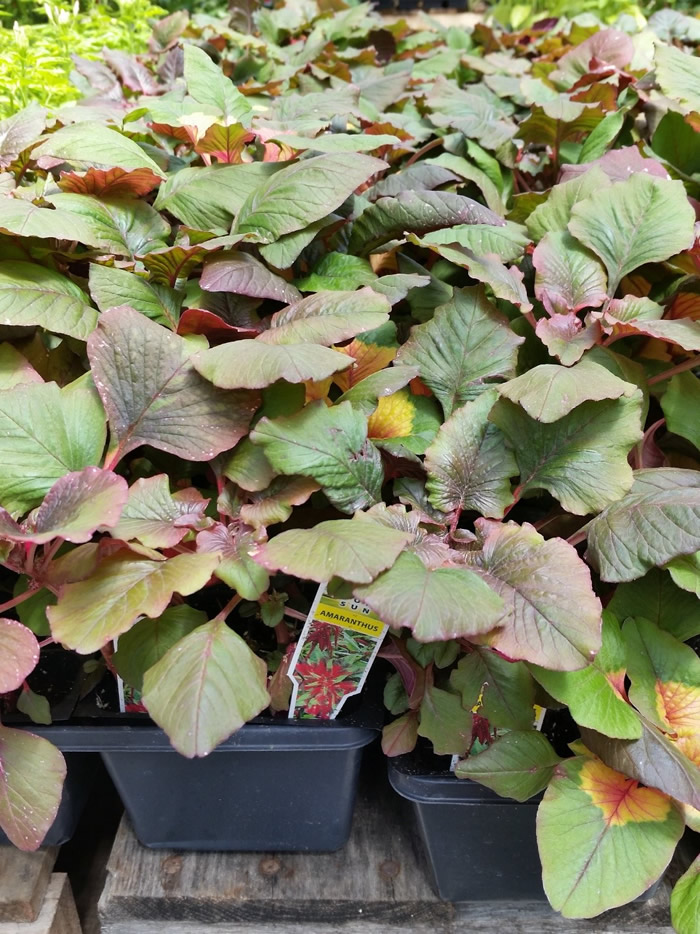Issue 9, August 24, 2020
Pigweeds (Amaranthus species) in the Landscape
Amaranthus species are commonly found in cultivated areas and landscape plantings throughout Illinois yet many are unfamiliar with them. The Midwest is home to several species including redroot pigweed (Amaranthus retroflexus), tall waterhemp (A. tuberculatus), Palmer amaranth (A. palmeri), tumble pigweed (A. albus), prostrate pigweed (A. blitoides), smooth (A. hybridus), spiny amaranth (A. spinosus), Powell amaranth (A. powellii), and others. All are similar in appearance with slight differences and cross-pollination can make identification quite difficult. All are summer annuals. In 2014, I warned landscapers and home gardeners about Palmer amaranth becoming a problem across the state in my article http://hyg.ipm.illinois.edu/article.php?id=609. For the sake of brevity, I’ll limit our focus here primarily to redroot pigweed and make comparisons to similar species.

Pigweed growing along the edge of a field. Credit: Michelle Wiesbrook
Redroot pigweed grows erect and branching. It has a shallow, reddish taproot; hence the name. If left to develop, this weed can grow 6 feet tall. The leaves are alternate, ovate, dull green with wavy margins and can grow up to 6 inches long. The leaves have notched tips and purple to pinkish midveins and undersides. The stems are very hairy and often reddish at the base. Lower stems may be smooth. The petioles have short stiff hairs and are purplish. The seed head is a bristly, stiff, spike-like terminal panicle. Flowers are small and greenish. Tall waterhemp and Palmer amaranth are quite similar to redroot pigweed. However, tall waterhemp leaves and stems are hairless and smooth, even waxy, and the leaves are narrower. Palmer amaranth also lacks hair, but the petiole is really long (often longer than the leaf blade) and a white or red V-shaped variegation may be present on the leaves. Spiny amaranth’s stem has a pair of sharp spines at the base of most leaves. Often, it is not easy or possible to differentiate among some pigweed species when plants are seedlings. To complicate matters, ornamental Amaranthus cultivars with brightly colored inflorescences and sometimes leaves are available for sale in the nursery trade. They too can become weedy and spread where they are not wanted. For more detailed information on pigweed identification, which focuses on floral characteristics, please see this 2001 article at http://bulletin.ipm.illinois.edu/pastpest/articles/200122g.html.

Ornamental amaranth growing in a landscape. Credit: Michelle Wiesbrook
Pigweeds grow best in fertile, sunny areas but can tolerate a variety of soil types. It is important to control pigweeds prior to seed production as one plant can produce hundreds of thousands of seeds. On average, pigweeds produce 13,000 to 35,000 seeds per plant according to colleagues at Michigan State University. However, reports from Iowa State University state that waterhemp plants can produce over 2 million seeds. Either way, that’s a lot of seeds. Prevention is imperative.

Ornamental amaranth for sale in a nursery. Credit: Michelle Wiesbrook
In landscape beds, pigweeds can be removed by hand. Of course smaller plants will be much easier to uproot than larger plants. Good soil moisture will help the removal process so wait a day or so after a rain to make your task much simpler with less effort (and less mud possibly). Large plants can be cut down at the base of the stem. Mowing and trimming can be effective, however, I’ve seen some pigweeds handle a fair amount of mowing. It’s rare to see it growing in turfgrass, however. Mulch or other groundcovers can be used in beds to block sunlight and thus prevent seed germination. Preemergent herbicide options include but are not limited to the following: benefin, dimethenamid, flumioxazin, isoxaben, oryzalin, oxyfluorfen, pendimethalin, prodiamine, and trifluralin. Combination products are available.

Palmer Amaranth’s TALL seedheads. Credit: Michelle Wiesbrook
Postemergent options can be challenging. For best results, plant size should be very small. Early summer would be best for these applications. Glyphosate can perhaps be used successfully unless resistance to this herbicide has evolved. I have had clients in rural areas with the problem of seed spread from neighboring agricultural crops. Repeated use of glyphosate to control Amaranthus species over time has resulted in populations that have evolved resistance to this active ingredient. So the homeowner who uses glyphosate (even for the first time) to control these weeds will not have much success unfortunately. In these situations, if plants are small (less than 4 inches) glufosinate can be used, but odds are good that this late in the year plants will be too large. Yes, it is similar sounding but an entirely different chemical. Depending on the area, dicamba or 2,4-D may be possible options. Please note that these products cannot be used in certain areas such as vegetable gardens or around sensitive plants as extensive plant damage can occur. When using any herbicide, be sure to carefully read and follow all label directions including information on resistance management. Tall waterhemp that is resistant to 2,4-D has been reported. In Illinois, there have been reports of resistance to several herbicide sites of action with tall waterhemp, Palmer amaranth, and smooth pigweed. For more information, check out: http://www.weedscience.org/Pages/USState.aspx?StateAbbr=IL.
Resources:
- Weeds of the Northeast
- https://www.canr.msu.edu/weeds/extension/pigweeds-redroot-pigweed-smooth-pigweed-and-powell-amaranth
- https://crops.extension.iastate.edu/encyclopedia/palmer-amaranth-id-biology-and-management
Author:
Michelle Wiesbrook